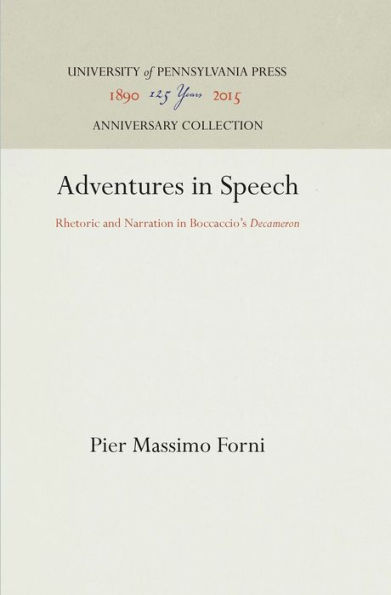Adventures in Speech: Rhetoric and Narration in Boccaccio's "Decameron"
Selected by Choice magazine as an Outstanding Academic Book for 1996
The Decameron is a narrative account of a situation in which narration takes place-a collection of one hundred stories set within a larger story. As a group of young men and women fleeing the plague trade stories to pass the time of crisis, storytelling occurs in a social context that allows for comment upon the tales by the tellers themselves, in a setting that elicits one story in return for another.
In his close and original analysis, Pier Massimo Forni uses the notion of rhetoric as a guiding principle for a critical assessment of the Decameron. He explores the discursive tools with which the narrators connect the contents of their stories to their audience's environment, and goes on to argue that the book is significantly marked by Boccaccio's habit of exploring the narrative potential of rhetorical forms.
By showing how the Decameron marks a new stage in the development of vernacular realism, Forni also charts a new course in Boccaccio criticism. Viewing the cultural and rhetorical context of the medieval masterpiece from a fresh perspective, he offers intriguing insights into the functioning of Boccaccio's narrative. Adventures in Speech maps the cognitive poetic processes that rule the complex authorial network of relationships involving speech, event, received culture, and narrative objects.
1125053878
The Decameron is a narrative account of a situation in which narration takes place-a collection of one hundred stories set within a larger story. As a group of young men and women fleeing the plague trade stories to pass the time of crisis, storytelling occurs in a social context that allows for comment upon the tales by the tellers themselves, in a setting that elicits one story in return for another.
In his close and original analysis, Pier Massimo Forni uses the notion of rhetoric as a guiding principle for a critical assessment of the Decameron. He explores the discursive tools with which the narrators connect the contents of their stories to their audience's environment, and goes on to argue that the book is significantly marked by Boccaccio's habit of exploring the narrative potential of rhetorical forms.
By showing how the Decameron marks a new stage in the development of vernacular realism, Forni also charts a new course in Boccaccio criticism. Viewing the cultural and rhetorical context of the medieval masterpiece from a fresh perspective, he offers intriguing insights into the functioning of Boccaccio's narrative. Adventures in Speech maps the cognitive poetic processes that rule the complex authorial network of relationships involving speech, event, received culture, and narrative objects.
Adventures in Speech: Rhetoric and Narration in Boccaccio's "Decameron"
Selected by Choice magazine as an Outstanding Academic Book for 1996
The Decameron is a narrative account of a situation in which narration takes place-a collection of one hundred stories set within a larger story. As a group of young men and women fleeing the plague trade stories to pass the time of crisis, storytelling occurs in a social context that allows for comment upon the tales by the tellers themselves, in a setting that elicits one story in return for another.
In his close and original analysis, Pier Massimo Forni uses the notion of rhetoric as a guiding principle for a critical assessment of the Decameron. He explores the discursive tools with which the narrators connect the contents of their stories to their audience's environment, and goes on to argue that the book is significantly marked by Boccaccio's habit of exploring the narrative potential of rhetorical forms.
By showing how the Decameron marks a new stage in the development of vernacular realism, Forni also charts a new course in Boccaccio criticism. Viewing the cultural and rhetorical context of the medieval masterpiece from a fresh perspective, he offers intriguing insights into the functioning of Boccaccio's narrative. Adventures in Speech maps the cognitive poetic processes that rule the complex authorial network of relationships involving speech, event, received culture, and narrative objects.
The Decameron is a narrative account of a situation in which narration takes place-a collection of one hundred stories set within a larger story. As a group of young men and women fleeing the plague trade stories to pass the time of crisis, storytelling occurs in a social context that allows for comment upon the tales by the tellers themselves, in a setting that elicits one story in return for another.
In his close and original analysis, Pier Massimo Forni uses the notion of rhetoric as a guiding principle for a critical assessment of the Decameron. He explores the discursive tools with which the narrators connect the contents of their stories to their audience's environment, and goes on to argue that the book is significantly marked by Boccaccio's habit of exploring the narrative potential of rhetorical forms.
By showing how the Decameron marks a new stage in the development of vernacular realism, Forni also charts a new course in Boccaccio criticism. Viewing the cultural and rhetorical context of the medieval masterpiece from a fresh perspective, he offers intriguing insights into the functioning of Boccaccio's narrative. Adventures in Speech maps the cognitive poetic processes that rule the complex authorial network of relationships involving speech, event, received culture, and narrative objects.
84.95
In Stock
5
1

Adventures in Speech: Rhetoric and Narration in Boccaccio's "Decameron"
176
Adventures in Speech: Rhetoric and Narration in Boccaccio's "Decameron"
176Hardcover
$84.95
84.95
In Stock

Product Details
| ISBN-13: | 9780812233384 |
|---|---|
| Publisher: | University of Pennsylvania Press, Inc. |
| Publication date: | 03/29/1996 |
| Series: | Anniversary Collection |
| Pages: | 176 |
| Product dimensions: | 6.00(w) x 9.00(h) x 0.69(d) |
| Lexile: | 1400L (what's this?) |
About the Author
From the B&N Reads Blog
